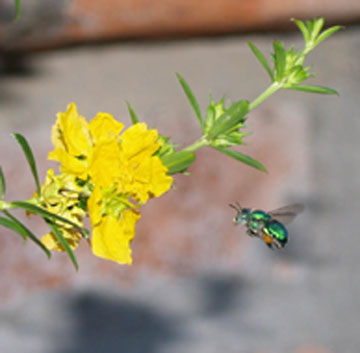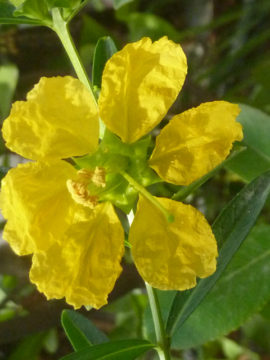FAMILY :: LYTHRACEAE
$200 – 400 pesos
SINICUICHE, Hierba de San Francisco: A many branched half-tender (hardy down to the mid 20ºs f.) shrub 3 or 4′ tall with narrow 2-3″ long leaves and ¾” yellow flowers in the summer. We have large and small flower varieties.
Grows in full sun or part shade and is very ornamental.
Used by some Mexican brujos to consult dead spirits and by others as a mild, strange dream-state inebriant. It is described medicinally as a febrifuge, diuretic, laxative, vermifuge, and hemostat. The leaves are used popularly in a poultice for “golpes e inflamaciones.”

I’ve located wild stands of Heimia here in Jalisco State. It seems to prefer (in the wild) to grow in small stream beds in quite heavy shade (that is provided by the steep arroyos I’ve found it in) and in very sandy, well-drained soil at about the 3-4000′ level of our Sierra Madre mountains. The native plants seem to be about a meter or a meter and a half tall by about the same diameter. The winters here are dry and warm and the summers are hot and humid. The wild plants start flowering in late January or February here.
 Many people who have used it claim that it is nothing to them other than a pleasant tasting tea; indeed, of the many times I’ve tried it, it has worked only once for me. In this instance, I fell into a dream state and was greeted with a myriad of Aztec motifs, and was given the permission to ask questions. I asked about people I knew and was given answers. The only one I remember was about a close woman friend, and the plant told me she was “an invisible revolving door.” Now, I know the Aztecs didn’t have revolving doors, but I doubt if I (though I am a poet —aren’t we all?) could have thought up this imagery myself. It’s difficult to define dreams.
Many people who have used it claim that it is nothing to them other than a pleasant tasting tea; indeed, of the many times I’ve tried it, it has worked only once for me. In this instance, I fell into a dream state and was greeted with a myriad of Aztec motifs, and was given the permission to ask questions. I asked about people I knew and was given answers. The only one I remember was about a close woman friend, and the plant told me she was “an invisible revolving door.” Now, I know the Aztecs didn’t have revolving doors, but I doubt if I (though I am a poet —aren’t we all?) could have thought up this imagery myself. It’s difficult to define dreams.
Traditionally, the fresh leaves are wilted and mixed with honey and water and lightly fermented in the sun before use. A translation of the Aztec word for this plant is “Sun opener.”